This article covers an extensive list of novel, valuable computer vision applications across all industries. Find the best computer vision projects, computer vision ideas, and high-value use cases in the market right now.
In this article, we will cover the following:
- The basics of Computer Vision systems
- 100 real-world applications of Computer Vision sorted by industry:
- Manufacturing
- Healthcare
- Agriculture
- Transportation
- Sports
- Examples, projects, and Computer Vision use cases
- Implementing Computer Vision
About us: viso.ai provides Viso Suite, the world’s only end-to-end Computer Vision Platform. The technology enables global organizations to develop, deploy, and scale all computer vision applications in one place. Get a demo.
Applications of Computer AI Vision Projects
What is Computer Vision?
The field of computer vision is a sector of Artificial Intelligence (AI) that uses Machine Learning and Deep Learning to enable computers to see, perform AI pattern recognition, and analyze objects in photos and videos in the same way that people do. Computational vision is rapidly gaining popularity for automated AI vision inspection, remote monitoring, and automation.
Computer Vision work has a massive impact on companies across industries, from retail to security, healthcare, construction, automotive, manufacturing, logistics, and agriculture.
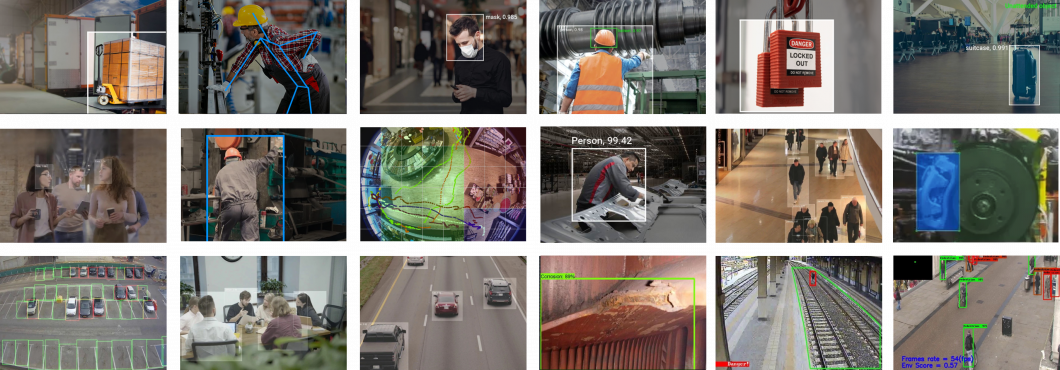
Computer Vision Systems
Computer vision systems use (1) cameras to obtain visual data, (2) machine learning models for processing the images, and (3) conditional logic to automate application-specific use cases. Edge intelligence then facilitates scalable, efficient, robust, secure, and private implementations of computer vision.
At viso.ai, we provide the world’s only end-to-end computer vision platform Viso Suite. The solution helps leading organizations develop, deploy, scale, and secure their computer vision applications in one place. Get the Whitepaper here.
Computer Vision Applications in Manufacturing
Read our complete manufacturing industry report here. In manufacturing, image recognition is applied for AI vision inspection, quality control, remote monitoring, and system automation.
Productivity Analytics
Productivity analytics track the impact of workplace change, how employees spend their time and resources, and implement various tools. Such data can provide valuable insight into time management, workplace collaboration, and employee productivity. Computer Vision lean management strategies aim to objectively quantify and assess processes with cameras-based vision systems.
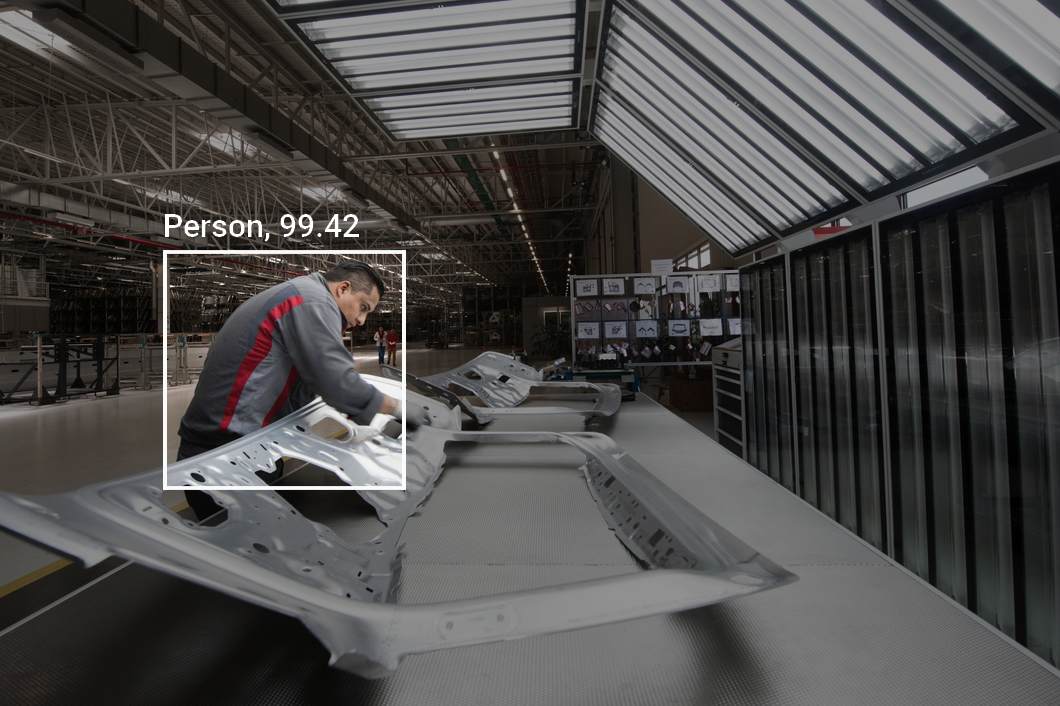
Visual Inspection of Equipment
Computer vision for visual inspection is a key strategy in smart manufacturing. Vision-based inspection systems are also gaining in popularity for automated inspection of Personal Protective Equipment (PPE), such as Mask Detection or Helmet Detection. Computational vision helps to monitor adherence to safety protocols on construction sites or in a smart factory.
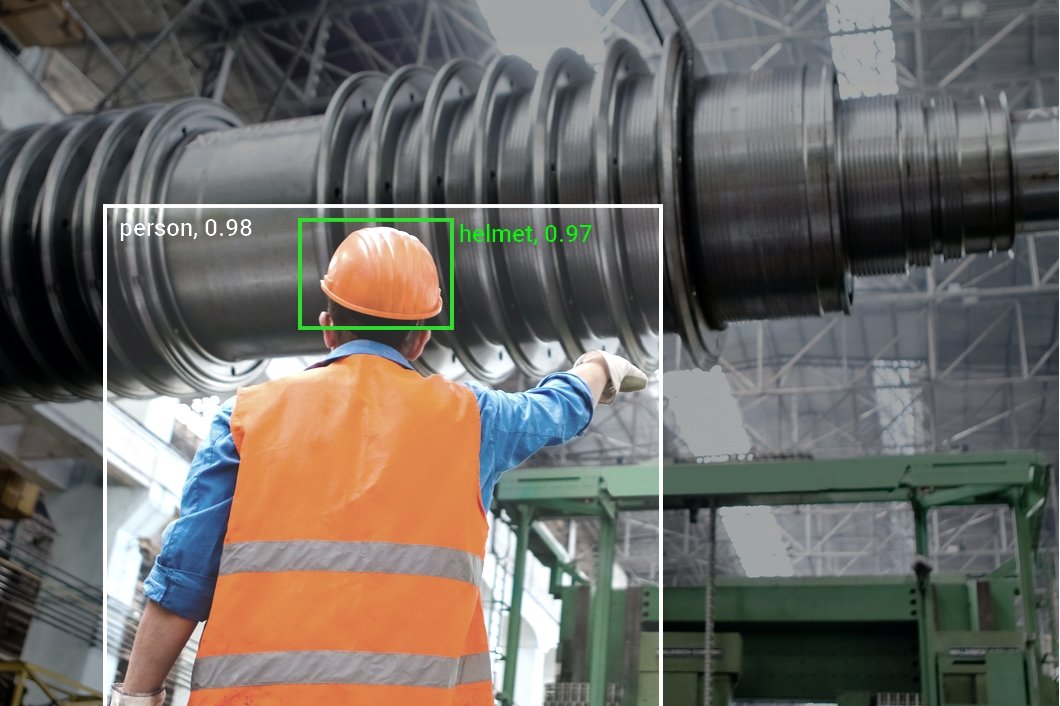
Quality Management
Smart camera applications provide a scalable method to implement automated visual inspection and quality control of production processes and assembly lines in smart factories. Hereby, deep learning uses real-time object detection to provide superior results (detection accuracy, speed, objectiveness, reliability) compared to laborious manual inspection.
Compared to traditional machine vision systems, AI vision inspection uses machine learning methods that are highly robust and don’t require expensive special cameras and inflexible settings. Therefore, AI vision methods are very scalable across multiple locations and factories.
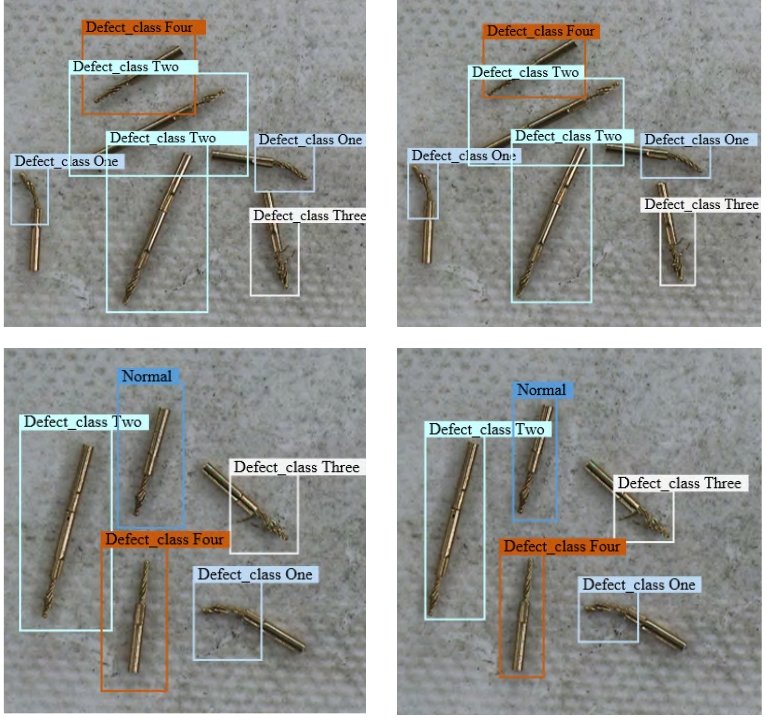
Skill Training
Another application field of vision systems is optimizing assembly line operations in industrial production and human-robot interaction. The evaluation of human action can help construct standardized action models related to different operation steps and evaluate the performance of trained workers.
Automatically assessing the action quality of workers can be beneficial by improving working performance, promoting productive efficiency (LEAN optimization), and, more importantly, discovering dangerous actions to lower accident rates.
Computer Vision in Healthcare
Read our healthcare industry report here.
Cancer Detection
Machine learning is incorporated into medical industries for purposes such as breast and skin cancer detection. For instance, image recognition allows scientists to detect slight differences between cancerous and non-cancerous images and diagnose data from magnetic resonance imaging (MRI) scans and inputted photos as malignant or benign.
COVID-19 diagnosis
Computer Vision can be used for coronavirus control. Multiple deep-learning computer vision models exist for x-ray-based COVID-19 diagnosis. The most popular one for detecting COVID-19 cases with digital chest x-ray radiography (CXR) images is named COVID-Net and was developed by Darwin AI, Canada.
Cell Classification
Machine Learning in medical use cases was used to classify T-lymphocytes against colon cancer epithelial cells with high accuracy. Thus, ML is expected to significantly accelerate the process of disease identification regarding colon cancer efficiently and at little to no cost post-creation.
Movement Analysis
Neurological and musculoskeletal diseases such as oncoming strokes, balance, and gait problems can be detected using deep learning models and computer vision even without doctor analysis. Pose Estimation computer vision applications that analyze patient movement assist doctors in diagnosing a patient with ease and increased accuracy.
Mask Detection
Masked Face Recognition is used to detect the use of masks and protective equipment to limit the spread of coronavirus. Likewise, computer Vision systems help countries implement masks as a control strategy to contain the spread of coronavirus disease.
For this reason, private companies such as Uber have created computer vision features such as face detection to be implemented in their mobile apps to detect whether passengers are wearing masks or not. Programs like this make public transportation safer during the coronavirus pandemic.
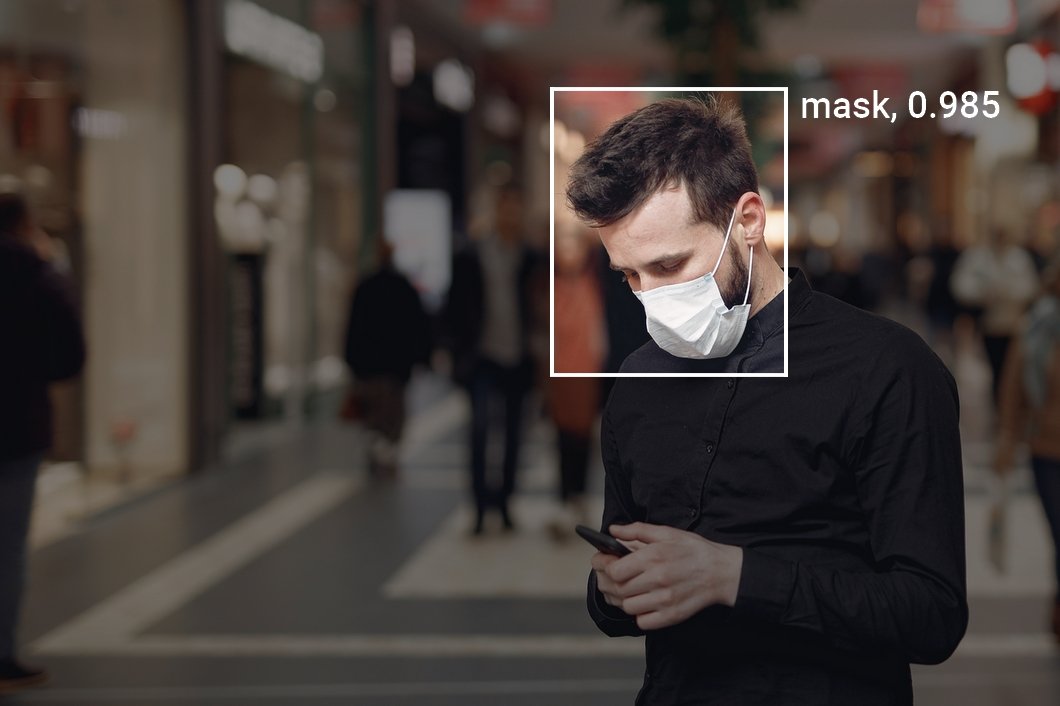
Tumor Detection
Brain tumors can be seen in MRI scans and are often detected using deep neural networks. Tumor detection software utilizing deep learning is crucial to the medical industry because it can detect tumors at high accuracy to help doctors make their diagnoses.
New methods are constantly being developed to heighten the accuracy of these diagnoses.
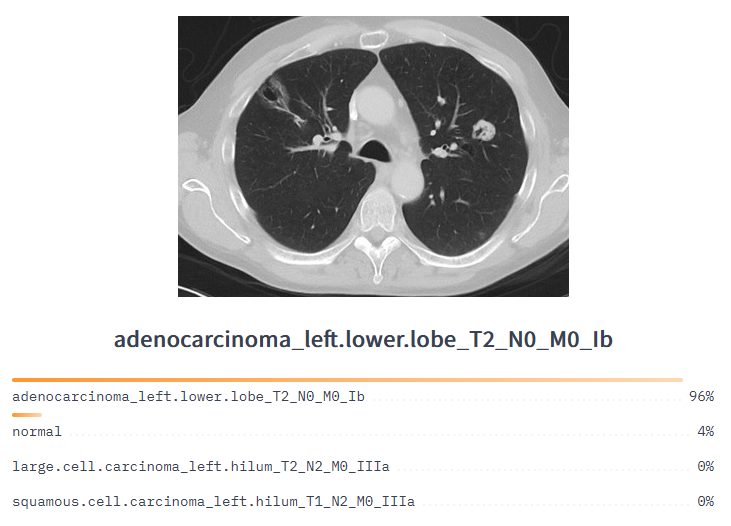
Disease Progression Score
Computer vision can be used to identify critically ill patients to direct medical attention (critical patient screening). People infected with COVID-19 are found to have more rapid respiration.
Deep Learning with depth cameras can be used to identify abnormal respiratory patterns to perform an accurate and unobtrusive yet large-scale screening of people infected with the COVID-19 virus.
Healthcare and Rehabilitation
Physical therapy is important for the recovery training of stroke survivors and sports injury patients. The main challenges are related to the costs of supervision by a medical professional, hospital, or agency.
Home training with a vision-based rehabilitation application is preferred because it allows people to practice movement training privately and economically. In computer-aided therapy or rehabilitation, human action evaluation can be applied to assist patients in training at home, guide them to perform actions properly and prevent further injuries. Explore more sports and fitness applications.
Medical Skill Training
Computer Vision applications are used for assessing the skill level of expert learners on self-learning platforms. For example, augmented reality simulation-based surgical training platforms have been developed for surgical education.
In addition, the technique of action quality assessment makes it possible to develop computational approaches that automatically evaluate the surgical students’ performance. Accordingly, meaningful feedback information can be provided to individuals and guide them to improve their skill levels.
Computer Vision in Agriculture
Read our agriculture industry report here.
Animal Monitoring
Animal monitoring with computer vision is a key strategy of smart farming. Machine learning uses camera streams to monitor the health of specific livestock such as pigs, cattle, or poultry. Smart vision systems aim to analyze animal behavior to increase productivity, health, and welfare of the animals and thereby influence yields and economic benefits in the industry.
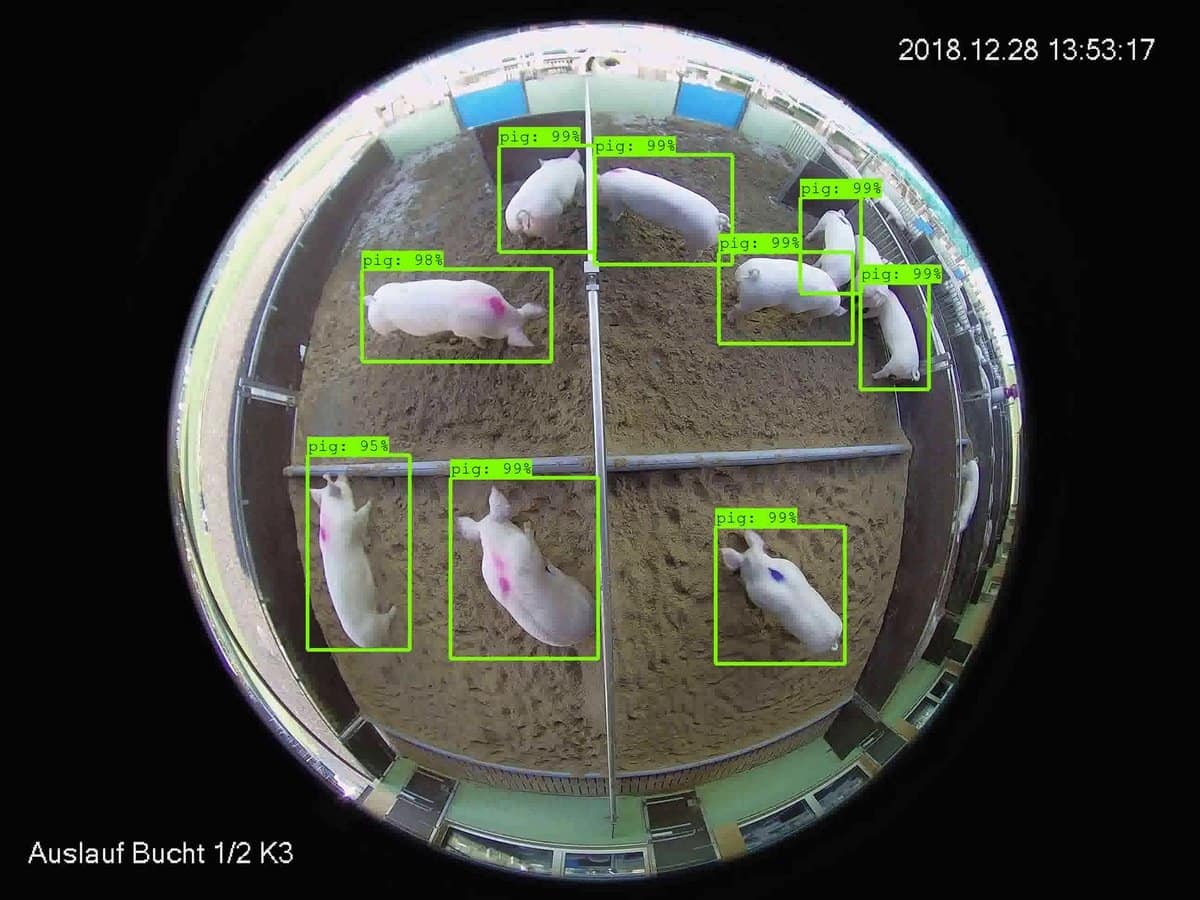
Farm Automation
Technologies such as harvest, seeding, and weeding robots, autonomous tractors, and vision systems to monitor remote farms, and drones for visual inspection can maximize productivity with labor shortages. The profitability can be significantly increased by automating manual inspection with AI vision, reducing the ecological footprint, and improving decision-making processes.
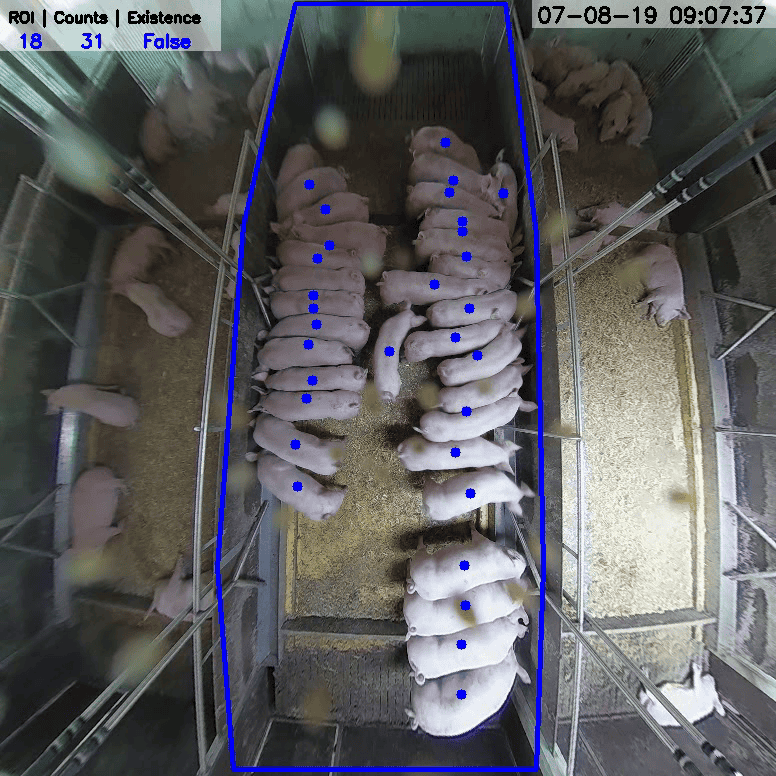
Crop Monitoring
The yield and quality of important crops such as rice and wheat determine the stability of food security. Traditionally, crop growth monitoring mainly relies on subjective human judgment and is not timely or accurate. Computer Vision applications allow us to continuously and non-destructively monitor plant growth and the response to nutrient requirements.
Compared with manual operations, the real-time monitoring of crop growth by applying computer vision technology can detect the subtle changes in crops due to malnutrition much earlier and can provide a reliable and accurate basis for timely regulation.
In addition, computer vision applications can be used to measure plant growth indicators or determine the growth stage.
Flowering Detection
The heading date of wheat is one of the most important parameters for wheat crops. An automatic computer vision observation system can be used to determine the wheat heading period.
Computer vision technology has the advantages of low cost, small error, high efficiency, and good robustness and can be dynamically and continuously analyzed.
Plantation Monitoring
In intelligent agriculture, image processing with drone images can be used to monitor palm oil plantations remotely. With geospatial orthophotos, it is possible to identify which part of the plantation land is fertile for planted crops.
It was also possible to identify areas less fertile in terms of growth. OpenCV is a popular tool for such image-processing tasks.
Insect Detection
Rapid and accurate recognition and counting of flying insects are of great importance, especially for pest control. However, traditional manual identification and counting of flying insects are inefficient and labor-intensive. Vision-based systems allow the counting and recognizing of flying insects (based on You Only Look Once (YOLO) object detection and classification).
Plant Disease Detection
Automatic and accurate estimation of disease severity is essential for food security, disease management, and yield loss prediction. The deep learning method avoids labor-intensive feature engineering and threshold-based image segmentation.
Automatic image-based plant disease severity estimation using Deep convolutional neural network (CNN) applications was developed, for example, to identify apple black rot.
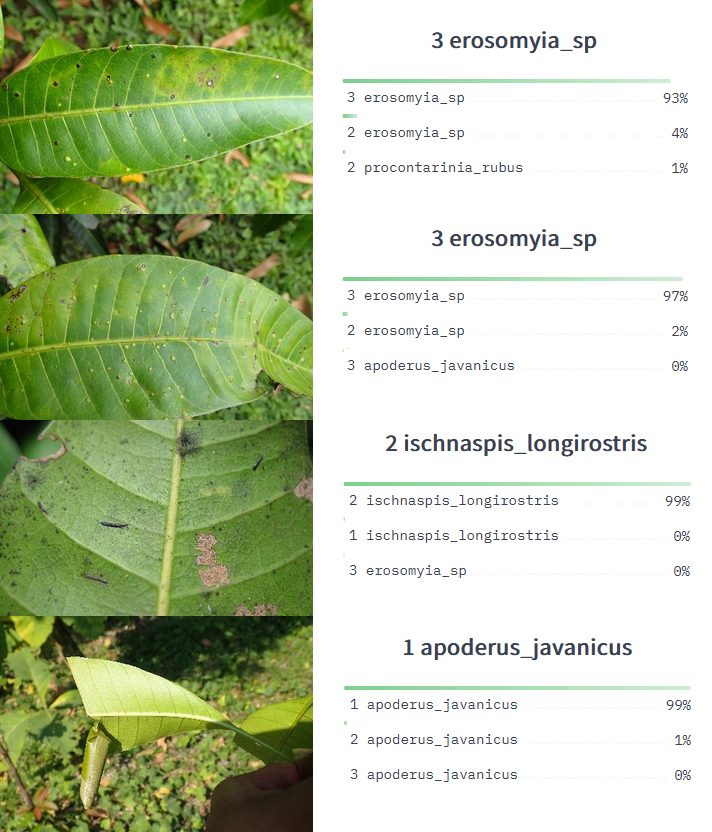
Automatic Weeding
Weeds are considered to be harmful plants in agronomy because they compete with crops to obtain water, minerals, and other nutrients in the soil. Spraying pesticides only in the exact locations of weeds greatly reduces the risk of contaminating crops, humans, animals, and water resources.
The intelligent detection and removal of weeds are critical to the development of agriculture. A neural network-based computer vision system can be used to identify potato plants and three different weeds for on-site specific spraying.
Automatic Harvesting
In traditional agriculture, mechanical operations are reliant, on manual harvesting as the mainstay, which results in high costs and low efficiency. However, in recent years, with the continuous application of computer vision technology, high-end intelligent agricultural harvesting machines, such as harvesting machinery and picking robots based on computer vision technology, have emerged in agricultural production, which has been a new step in the automatic harvesting of crops.
The main focus of harvesting operations is to ensure product quality during harvesting to maximize the market value. Computer Vision-powered applications include picking cucumbers automatically in a greenhouse environment or the automatic identification of cherries in a natural environment.
Agricultural Product Quality Testing
The quality of agricultural products is one of the important factors affecting market prices and customer satisfaction. Compared to manual inspections, Computer Vision provides a way to perform external quality checks.
AI vision systems can achieve high degrees of flexibility and repeatability at a relatively low cost and with high precision. For example, systems based on machine vision and computer vision are used for rapid testing of sweet lemon damage or non-destructive quality evaluation of potatoes.
Irrigation Management
Soil management based on using technology to enhance soil productivity through cultivation, fertilization, or irrigation has a notable impact on modern agricultural production. By obtaining useful information about the growth of horticultural crops through images, the soil water balance can be accurately estimated to achieve accurate irrigation planning.
Computer vision applications provide valuable information about the irrigation management water balance. A vision-based system can process multi-spectral images taken by unmanned aerial vehicles (UAVs) and obtain the vegetation index (VI) to provide decision support for irrigation management.
UAV Farmland Monitoring
Real-time farmland information and an accurate understanding of that information play a basic role in precision agriculture. Over recent years, drones (UAV), as a rapidly advancing technology, have allowed the acquisition of agricultural information that has a high resolution, low cost, and fast solutions.
In addition, UAV platforms equipped with image sensors provide detailed information on agricultural economics and crop conditions (for example, continuous crop monitoring). As a result, UAV remote sensing has contributed to an increase in agricultural production with a decrease in agricultural costs.
Yield Assessment
Through the application of computer vision technology, the functions of soil management, maturity detection, and yield estimation for farms have been realized. Moreover, the existing technology can be well applied to methods such as spectral analysis and deep learning.
Most of these methods have the advantages of high precision, low cost, good portability, good integration, and scalability and can provide reliable support for management decision-making. An example is the estimation of citrus crop yield via fruit detection and counting using computer vision.
Also, the yield from sugarcane fields can be predicted by processing images obtained using UAVs.
Computer Vision in Transportation
Read our smart city industry report here.
Vehicle Classification
Computer Vision applications for automated vehicle classification have a long history. The technologies for automated vehicle classification for vehicle counting have been evolving over the decades. Deep learning methods make it possible to implement large-scale traffic analysis systems using common, inexpensive security cameras.
With rapidly growing affordable sensors such as closed‐circuit television (CCTV) cameras, light detection and ranging (LiDAR), and even thermal imaging devices, vehicles can be detected, tracked, and categorized in multiple lanes simultaneously. The accuracy of vehicle classification can be improved by combining multiple sensors such as thermal imaging, and LiDAR imaging with RGB cameras (common surveillance, IP cameras).
In addition, there are multiple specializations; for example, a deep-learning-based computer vision solution for construction vehicle detection has been employed for purposes such as safety monitoring, productivity assessment, and managerial decision-making.
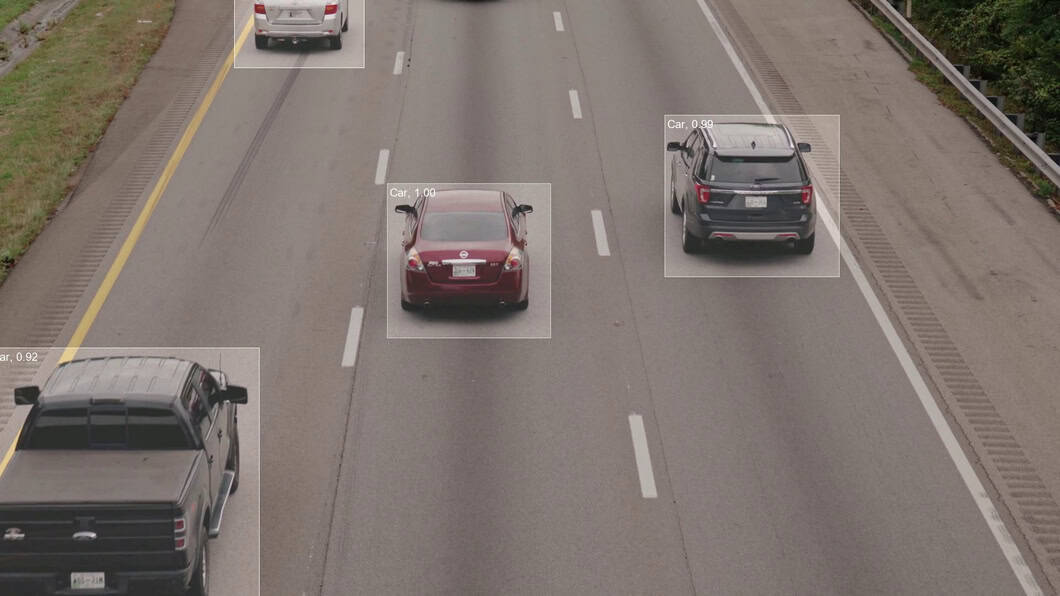
Moving Violations Detection
Law enforcement agencies and municipalities are increasing the deployment of camera‐based roadway monitoring systems to reduce unsafe driving behavior. Probably the most critical application is the detection of stopped vehicles in dangerous areas.
Also, there is increasing use of computer vision techniques in smart cities that involve automating the detection of violations such as speeding, running red lights or stop signs, wrong‐way driving, and making illegal turns.
Traffic Flow Analysis
Traffic flow analysis has been studied extensively for intelligent transportation systems (ITS) using invasive methods (tags, under-pavement coils, etc.) and non-invasive methods such as cameras.
With the rise of computer vision and AI, video analytics can now be applied to ubiquitous traffic cameras, which can generate a vast impact in ITS and smart cities. The traffic flow can be observed using computer vision means and measure some of the variables required by traffic engineers.
Parking Occupancy Detection
Visual parking space monitoring is used with the goal of parking lot occupancy detection. Especially in smart cities, computer vision applications power decentralized and efficient solutions for visual parking lot occupancy detection based on a deep Convolutional Neural Network (CNN).
There exist multiple datasets for parking lot detection, such as PKLot and CNRPark-EXT. Furthermore, video-based parking management systems have been implemented using stereoscopic imaging (3D) or thermal cameras. The advantage of camera-based parking lot detection is the scalability for large-scale use, inexpensive maintenance, and installation, especially since it is possible to reuse security cameras.
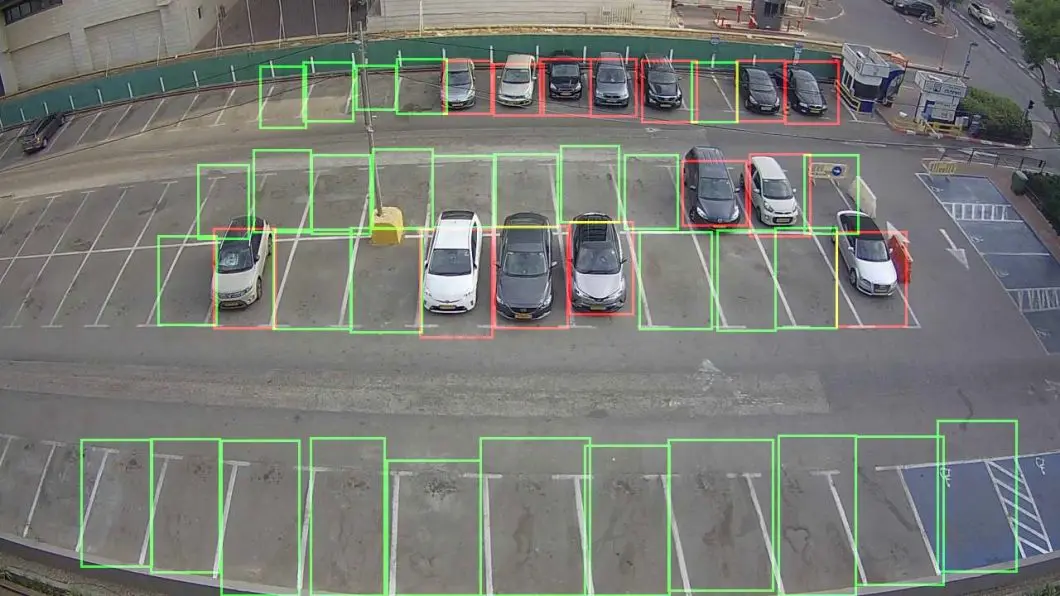
Automated License Plate Recognition (ALPR)
Many modern transportation and public safety systems rely on recognizing and extracting license plate information from still images or videos. Automated license plate recognition (ALPR) has in many ways transformed the public safety and transportation industries.
Such number plate recognition systems enable modern tolled roadway solutions, providing tremendous operational cost savings via automation and even enabling completely new capabilities in the marketplace (such as police cruiser‐mounted license plate reading units).
OpenALPR is a popular automatic number-plate recognition library based on optical character recognition (OCR) on images or video feeds of vehicle registration plates.
Vehicle re-identification
With improvements in person re-identification, smart transportation, and surveillance systems aim to replicate this approach for vehicles using vision-based vehicle re-identification. Conventional methods to provide a unique vehicle ID are usually intrusive (in-vehicle tag, cellular phone, or GPS).
For controlled settings such as at a toll booth, automatic number-plate recognition (ANPR) is probably the most suitable technology for the accurate identification of individual vehicles. However, license plates are subject to change and forgery, and ALPR cannot reflect salient specialties of the vehicles, such as marks or dents.
Non-intrusive methods such as image-based recognition have high potential and demand but are still far from mature for practical usage. Most existing vision-based vehicle re-identification techniques are based on vehicle appearances such as color, texture, and shape.
Today, the recognition of subtle, distinctive features such as vehicle make or year model is still an unresolved challenge.
Pedestrian Detection
The detection of pedestrians is crucial to intelligent transportation systems (ITS). Use cases range from self-driving cars to infrastructure surveillance, traffic management, transit safety and efficiency, and law enforcement.
Pedestrian detection involves many types of sensors, such as traditional CCTV or IP cameras, thermal imaging devices, near‐infrared imaging devices, and onboard RGB cameras. A person detection algorithm, or people detector, can be based on infrared signatures, shape features, gradient features, machine learning, or motion features.
Pedestrian detection relying on deep convolution neural networks (CNN) has made significant progress, even with the detection of heavily occluded pedestrians.
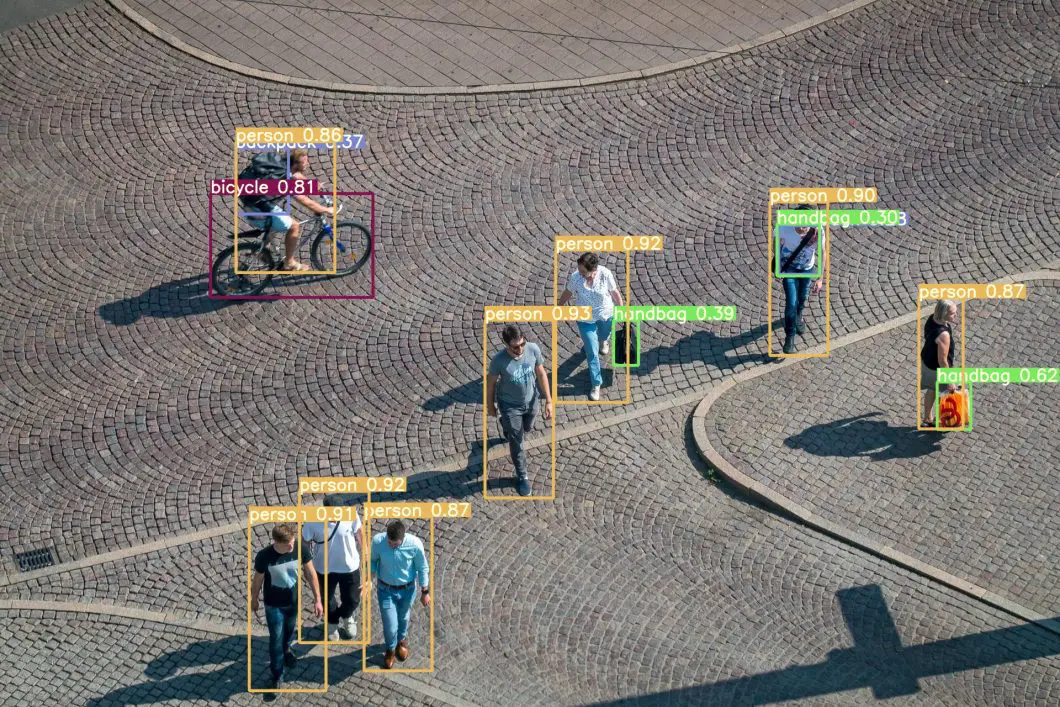
Traffic Sign Detection
Computer Vision applications are useful for traffic sign detection and recognition. Vision techniques are applied to segment traffic signs from different traffic scenes (using image segmentation) and employ deep learning algorithms to recognize and classify traffic signs.
Collision Avoidance Systems
Vehicle detection and lane detection form an integral part of most autonomous vehicle advanced driver assistance systems (ADAS). Deep neural networks have been used recently to investigate deep learning and its use for autonomous collision avoidance systems.
Road Condition Monitoring
Computer vision-based defect detection and condition assessment are developed to monitor concrete and asphalt civil infrastructure. Pavement condition assessment provides information to make more cost-effective and consistent decisions regarding the management of pavement networks.
Generally, pavement distress inspections are performed using sophisticated data collection vehicles and/or foot-on-ground surveys. A Deep Machine Learning Approach to develop an asphalt pavement condition index was developed to provide a human-independent, inexpensive, efficient, and safe way of automated pavement distress detection via Computer Vision.
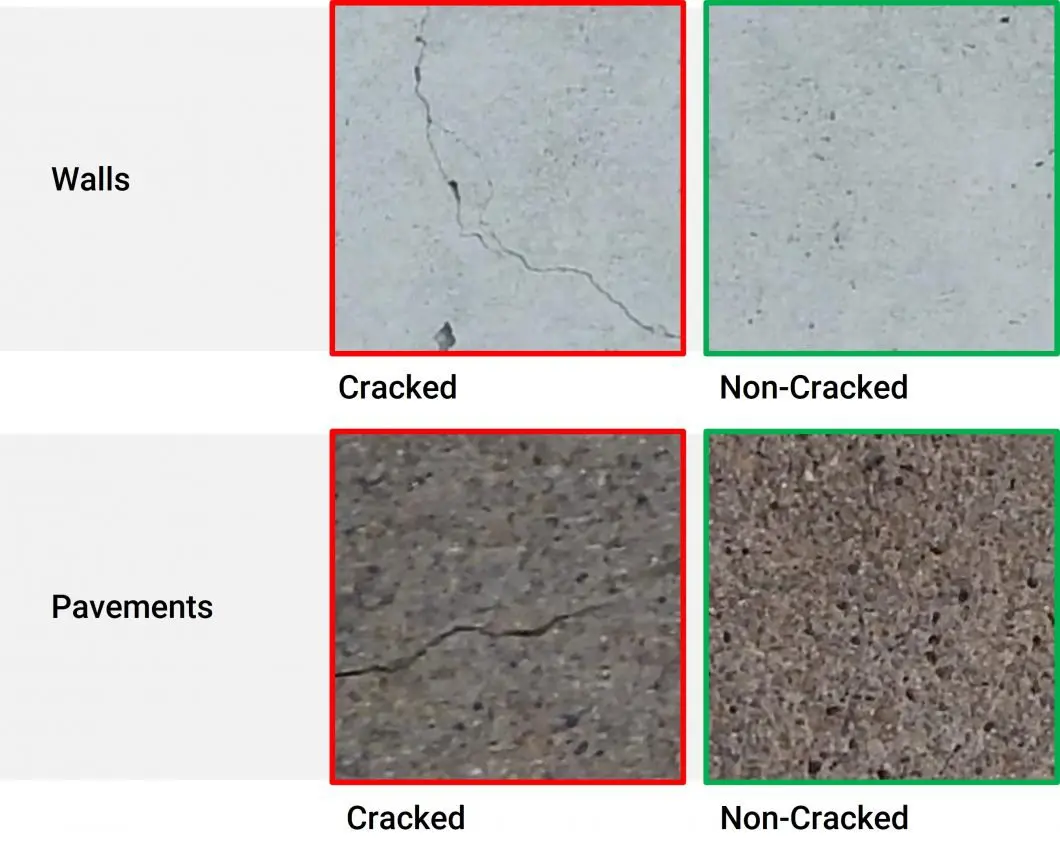
Another application is the visual inspection of roads to detect road potholes and allocate road maintenance to reduce related vehicle accidents.
Infrastructure Condition Assessment
To ensure civil infrastructure’s safety and serviceability, it is essential to visually inspect and assess its physical and functional condition. Systems for Computer Vision-based civil infrastructure inspection and monitoring automatically convert image and video data into actionable information.
Smart inspection applications identify structural components, characterize visible damage, and detect changes from reference images. Such monitoring applications include static measurement of strain and displacement and dynamic measurement of displacement for modal analysis.
Driver Attentiveness Detection
Distracted driving detection – such as daydreaming, cell phone usage, and looking at something outside the car – accounts for a large proportion of road traffic fatalities worldwide. Artificial intelligence helps understand driving behaviors and find solutions to mitigate road traffic incidents.
Road surveillance technologies observe passenger compartment violations, for example, in deep learning-based seat belt detection in road surveillance. In‐vehicle driver monitoring technologies focus on visual sensing, analysis, and feedback.
Driver behavior can be inferred both directly from inward driver‐facing cameras and indirectly from outward scene‐facing cameras or sensors. Techniques based on driver-facing video analytics detect the face and eyes with algorithms for gaze direction, head pose estimation, and facial expression monitoring.
Face detection algorithms have been able to detect attentive vs. inattentive faces. Deep Learning algorithms can detect differences between focused and unfocused eyes, as well as signs of driving under the influence.
Multiple vision-based applications for real-time distracted driver posture classification with multiple deep learning methods (RNN and CNN) are used in real-time distraction detection.
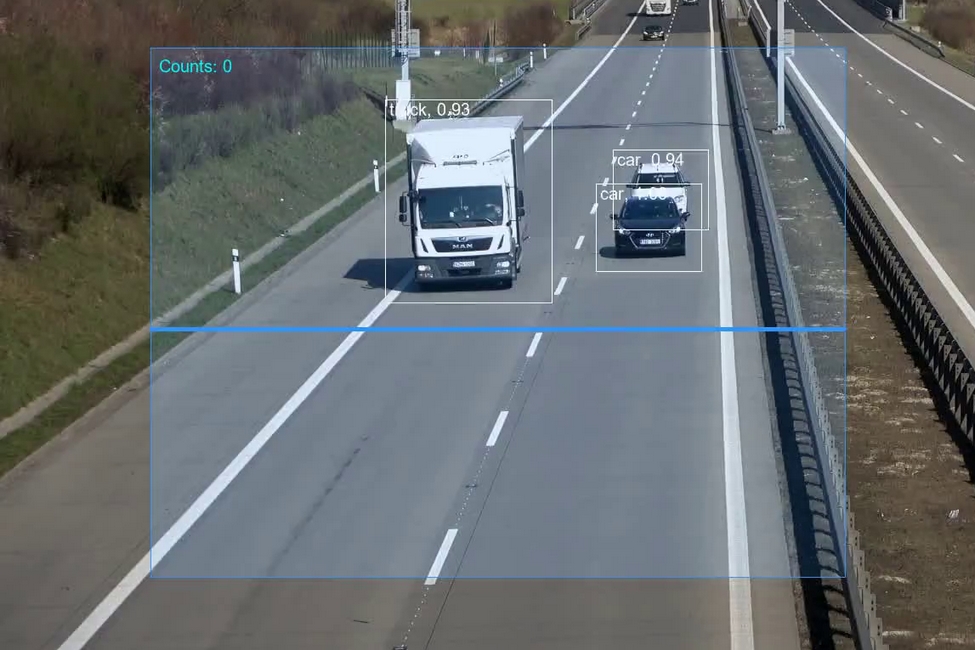
Computer Vision in Retail
Read our retail industry report here.
Customer Tracking
Deep learning algorithms can process the video streams in real time to analyze customer footfall in retail stores. Camera-based methods allow re-using the video stream of common, inexpensive security surveillance cameras. Machine learning algorithms detect people anonymously and contactless to analyze time spent in different areas, waiting times, queueing time, and assess the service quality.
Customer behavior analytics can improve retail store layouts, increase customer satisfaction, and quantify key metrics across multiple locations.
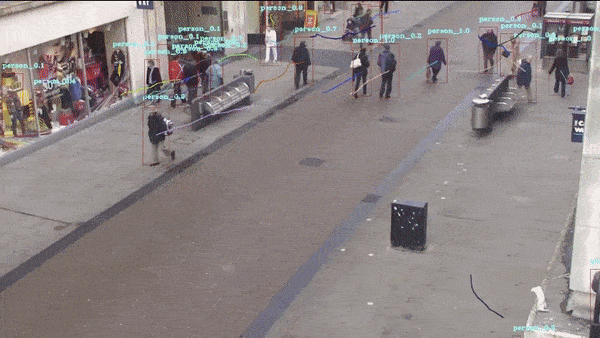
People Counting
Computer Vision algorithms learn from training data to detect humans and count them in real-time. People counting technology helps stores collect data about their stores’ success. During the COVID-19 pandemic, it tracked customers when a limited number of people could enter stores.
Theft Detection
Retailers can detect suspicious behavior, such as loitering or accessing off-limits areas, using computer vision algorithms that autonomously analyze the scene.
Waiting Time Analytics
To prevent impatient customers and endless waiting lines, retailers are implementing queue detection technology. Queue detection uses cameras to track and count the number of shoppers in a line. Once a threshold of customers is reached, the system sounds an alert for clerks to open new checkouts.
Social Distancing
To ensure adherence to safety precautions, companies implement distance detectors. A camera tracks employee or customer movement and uses depth sensors to assess the distance between them. Then, depending on their position, the system draws a red or green circle around the person. Learn more about Social Distancing Monitoring with deep learning.
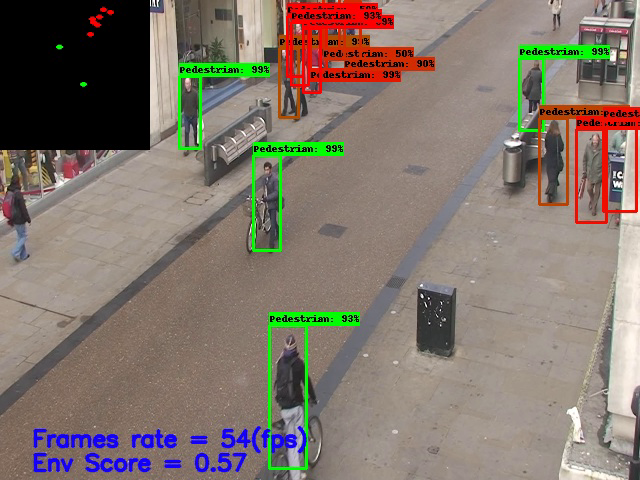
Computer Vision in Sports
For a comprehensive report, explore our article about computer vision in sports.
Player Pose Tracking
AI vision recognizes patterns between human body movement and poses over multiple frames in video footage or streams. For example, human pose estimation has been applied to real-world videos of swimmers where single stationary cameras film above and below the water surface. A popular open-source tool for this is Openpose, useful for real-time keypoint detection.
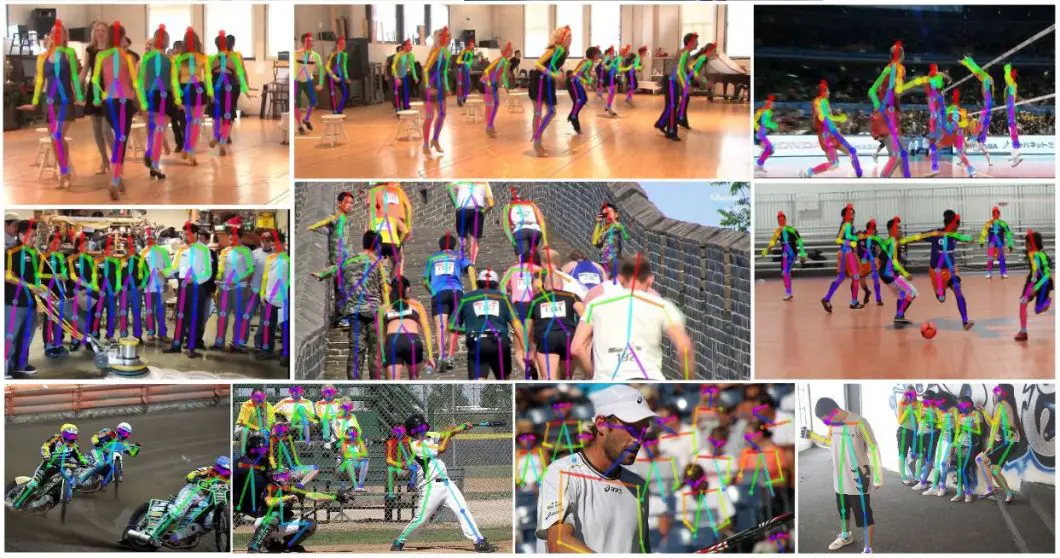
Those video recordings can quantitatively assess the athletes’ performance without manual body part annotation in each video frame. Thus, Convolutional Neural Networks automatically infer the required pose information and detect athletes’ swimming styles.
Markerless Motion Capture
Cameras use pose estimation to track the motion of the human skeleton without using traditional optical markers and specialized cameras. This is essential in sports capture, where players cannot play with the burden of additional performance capture attire or devices.
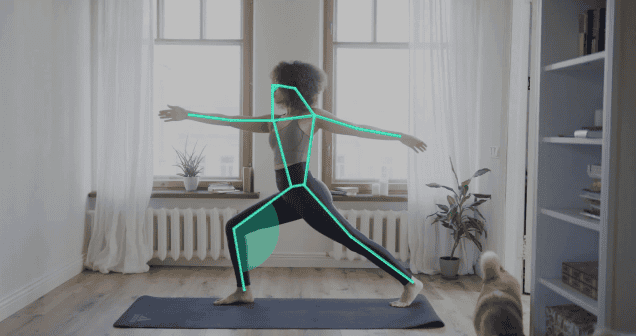
Performance Assessment
Automated detection and recognition of sport-specific movements overcome the limitations associated with manual performance analysis methods (subjectivity, quantification, reproducibility). Computer Vision data inputs can be used in combination with the data of body-worn sensors and wearables. Popular use cases are swimming analysis, golf swing analysis, over-ground running analytics, alpine skiing, and the detection and evaluation of cricket bowling.
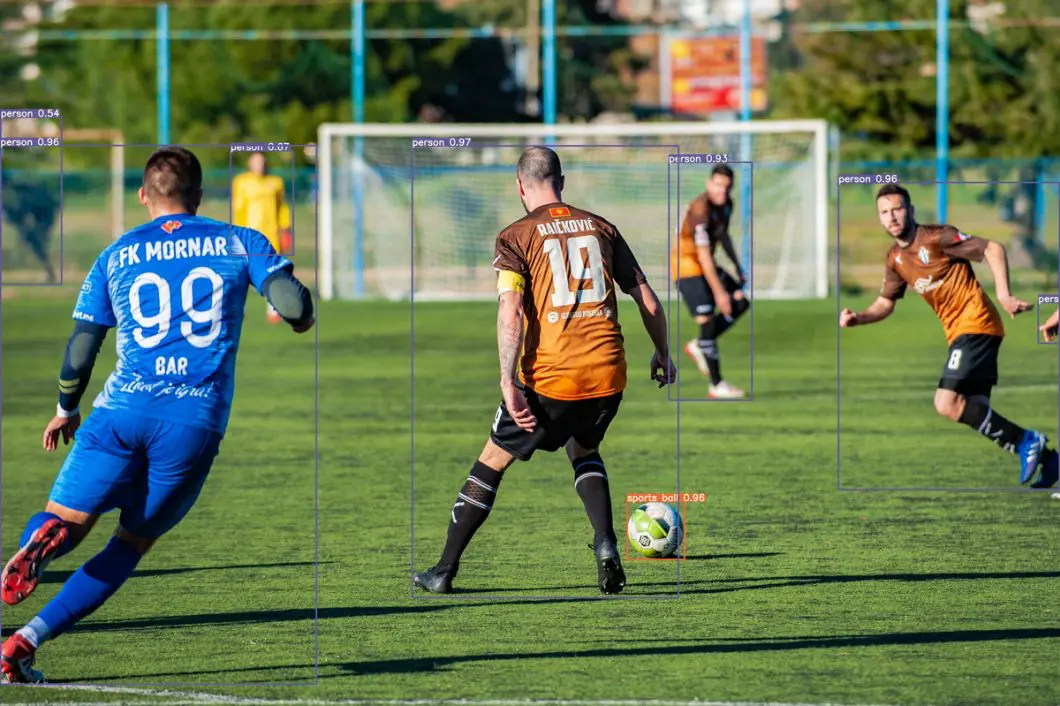
Multi-Player Pose Tracking
Using Computer Vision algorithms, the human pose and body movement of multiple team players can be calculated from both monocular (single-camera footage), and multi-view (footage of multiple cameras) sports video datasets. 2D or 3D Pose of multiple players in sports is useful in performance analysis, motion capture, and novel applications in broadcast and immersive media.
Stroke Recognition
Computer vision applications are capable of detecting and classifying strokes (for example, classifying strokes in table tennis). Movement recognition or classification involves interpretations and labeled predictions of the identified instance. I.e., differentiating tennis strokes as forehand or backhand).
Stroke recognition aims to provide tools to analyze table tennis games and to improve sports skills more efficiently.
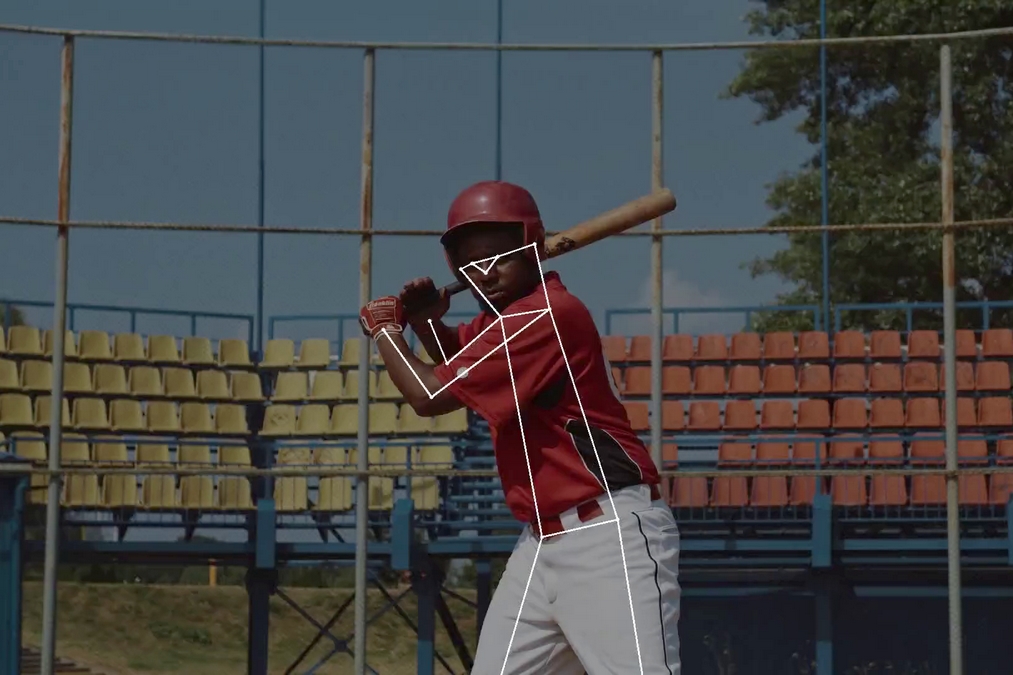
Real-Time Coaching
Computer Vision-based sports video analytics help to improve resource efficiency and reduce feedback times for time-constraint tasks. Coaches and athletes involved in time-intensive notational tasks, including post-swim race analysis, can review rapid, objective feedback before the next race.
Self-training systems for sports exercise is a similar recently emerging computer vision research topic. While self-training is essential in sports exercise, a practitioner may progress to a limited extent without a coach’s instruction.
For example, a yoga self-training application aims to instruct the practitioner to perform yoga poses correctly. Thus, assisting in rectifying poor postures and preventing injury. In addition, vision-based self-training systems can give instructions on how to adjust body posture.
Sports Team Analysis
Professional sports analysts regularly perform analysis to gain strategic and tactical insights into player and team behavior. However, manual video analysis is typically time-consuming, where the analysts need to memorize and annotate scenes.
Computer Vision techniques extract trajectory data from video material and apply movement analysis techniques to analyze:
- Regions
- Team formations
- Events
- Player movements(i.e., soccer team sports analysis).
Ball Tracking
Real-time object tracking detects and captures object movement patterns. Ball trajectory data is fundamental in evaluating players’ performance and analysis of game strategies. Hence, tracking of ball movement detects and then tracks the ball across multiple video frames.
Ball tracking is important in sports with large fields to help interpret and analyze a sports game and tactics faster.
Goal-Line Technology
Camera-based systems can determine the validity of a goal to support the decision-making of referees. Unlike sensors, the AI vision-based method is noninvasive and does not require changes to typical football devices.
Such Goal-Line Technology systems are based on high-speed cameras with images to triangulate the ball’s position. A ball detection algorithm that analyzes candidate ball regions to recognize the ball pattern.
Event Detection in Sports
We can detect complex events from unstructured videos, like scoring a goal, near misses, or other non-scoring actions. This technology is useful for real-time event detection in sports broadcasts, applicable to a wide range of field sports.
Highlight Generation
Producing sports highlights is labor-intensive work requiring some degree of specialization. This is especially true for sports with complex rules and extensive play periods (e.g., Cricket). Automatic Cricket highlight generation can use event-driven and excitement-based features to recognize and clip important match events.
Another application is the automatic curation of golf highlights using multimodel excitement features with Computer Vision.
Sports Activity Scoring
Deep Learning methods can assess athletes’ action quality (Deep Features for Sports Activity Scoring). For example, automatic sports activity scoring for diving, figure skating, or vaulting. ScoringNet is a 3D model CNN network application for sports activity scoring.
For example, a diving scoring application works by assessing the quality score of a diving performance of an athlete. It analyzes the position of the athlete’s feet to determine:
- Feet stuck together
- Toes pointed
- Position held straight throughout the whole diving process
AI Vision Industry Guides and Applications of Computer Vision Projects
Organizations use deep and machine learning technology to create countless computer vision algorithms and applications across industry lines. Read our industry guides to find more industry-specific applications and get computer vision ideas from real-world case studies.
- Guide #1: Computer Vision in Retail
- Guide #2: Computer Vision In Manufacturing
- Guide #3: Computer Vision Smart Cities
- Guide #4: Computer Vision in Agriculture and Smart Farming
- Guide #5: Computer Vision in the Education Sector
- Guide #6: Computer Vision Smart Cities
- Guide #7: Computer Vision In Healthcare
- Guide #8: Computer Vision in Oil and Gas
- Guide #9: Computer Vision in Automotive
- Guide #10: Computer Vision in Insurance
- Guide #11: Computer Vision in Sports
- Guide #12: Computer Vision in Aviation
- Guide #13: Computer Vision in Construction
- Guide #11: Computer Vision Companies and Startups
Enterprise Computer AI Vision Algorithms and Applications
At viso.ai, we power Viso Suite, the most complete end-to-end computer vision platform. Industry leaders, Fortune 100, and governmental organizations develop and deploy their computer vision applications with software infrastructure from viso.ai.
Viso Suite provides full-scale features to rapidly build, deploy, and scale enterprise-grade computer vision applications. Viso helps to overcome integration hassles, privacy, security, and scalability challenges – without writing code from scratch.
- Use our end-to-end solution to build, deploy, and scale enterprise computer vision systems.
- Choose from a variety of computer vision tasks to solve your business challenge
- Deliver computer vision 10x faster with visual programming
- Use the video input of any conventional camera (surveillance cameras, CCTV, USB, etc.).
We provide all the computer vision services and AI vision experience you’ll need. Get in touch with our team of AI experts and schedule a demo to see the key features.


